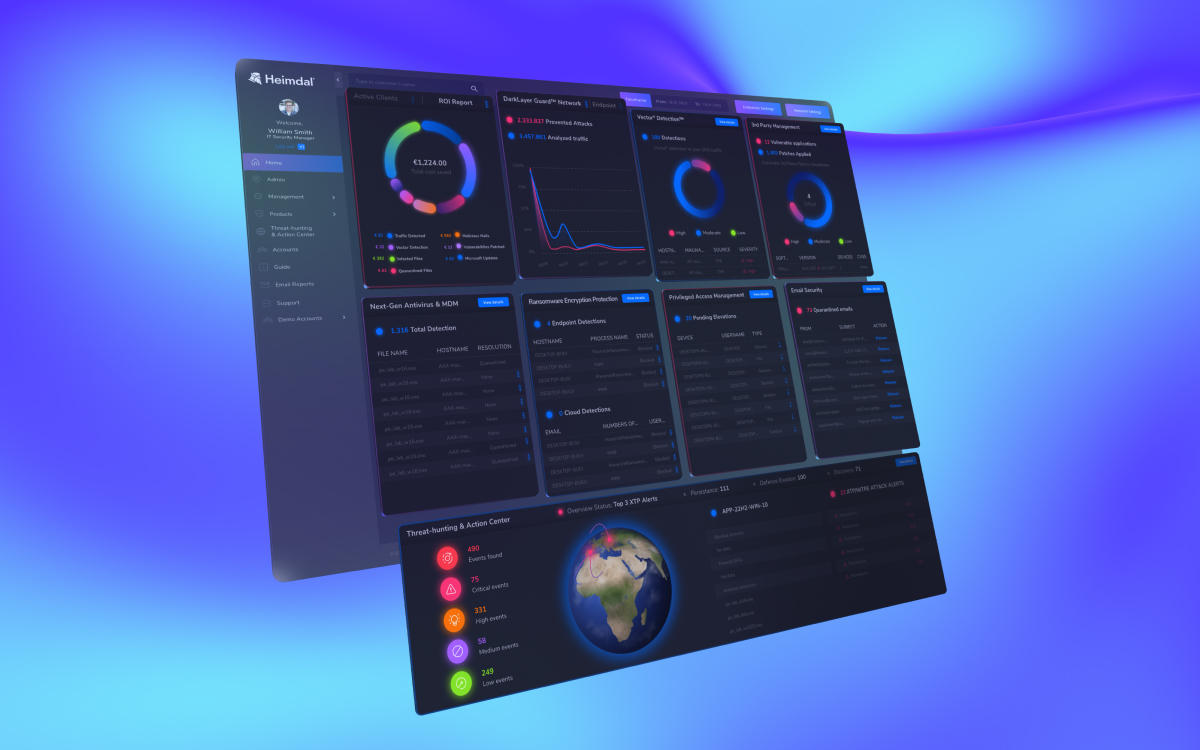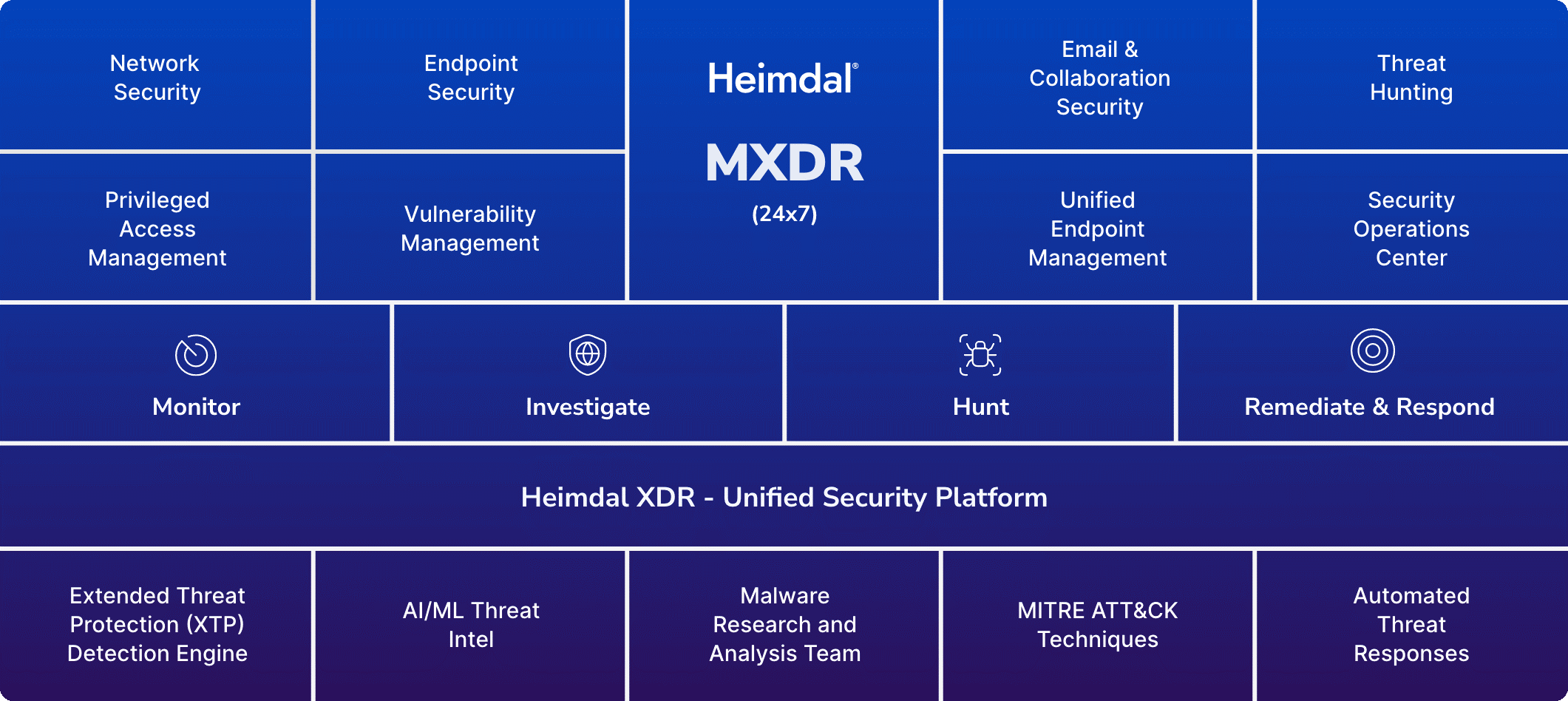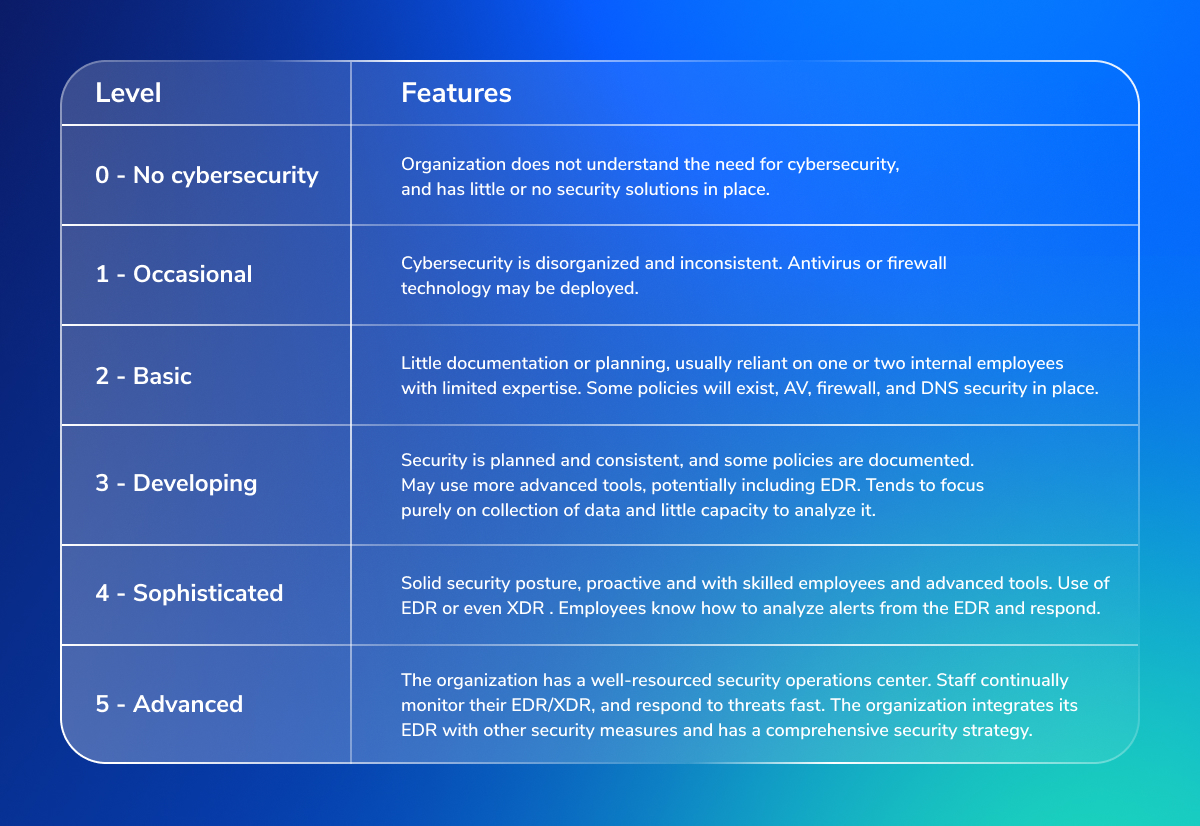In 2021, it was revealed that a group of hackers dubbed ‘LightBasin’ had compromised over a dozen telecom firms around the world. Their activity had been going on, undetected, for at least five years. This breach is a classic example of an advanced persistent threat, with the hackers stealthily entering their victims’ systems and stealing customer data.
How can you protect your organization against these kinds of sophisticated cyber threats? One key method is endpoint detection and response (EDR) technology.
Let’s learn more about this technology, and explore EDR’s importance for businesses.
Key Takeaways:
- Learn what EDR is;
- Find out about why endpoint security is important in defending against cyber threats;
- Read about uses cases of EDR;
- Learn where EDR fits in the cybersecurity maturity model.
Reminder: What Is EDR?
EDR is a group of integrated endpoint security solutions that combine data collection, data analysis, forensics and threat hunting with the end goal of identifying and stopping any potential security breaches in due time.
[embedded content]
An endpoint detection and response solution is deployed on your company’s networks and all endpoints that connect to it. This includes laptops, desktops, USBs, mobile devices, tablets, printers and anything else.
Typically, a lightweight agent is installed on the devices, and then monitors them for unusual behavior.
If any suspicious events occur, the EDR solution will trigger an alert and notify your security teams. Some EDR solutions may also automatically isolate devices when they ‘notice’ potential breaches and cyber threats.
For a complete overview of EDR and endpoint security, read our comprehensive guide.
EDR Importance – Why Is This Tech Needed?
EDR is crucial; it’s a foundational control. Businesses, regardless of size, need it, especially as cyber insurance carriers recognize its importance. It’s like putting locks on your doors – a necessary step for awareness and security.
As of late 2023, a Gartner study found that 57% of organizations have some kind of EDR deployed. If your business has not yet rolled an EDR solution out – or the process has stalled – it’s worth considering EDR’s importance.
While it certainly isn’t a ‘silver bullet’ that will protect you against all threats, it is undeniably valuable.
Here are some of the key reasons that EDR is an important part of most organizations’ security posture.
7 Reasons EDR Is Important
Gives You Another Layer of Protection
As the ‘LightBasin’ example we outlined above illustrates, modern cyber criminals are far more sophisticated than in the past. Once they gain access to your systems, many will spend weeks or even months quietly stealing your data.
EDR solutions are a form of defense in depth, giving you an extra level of protection against potential threats. If a criminal has bypassed your firewall and antivirus solution, then the EDR may still be able to detect suspicious system behavior.
If it notices suspicious activity, code, or movement of data, it will send an alert to your security teams and help them investigate.
[Info stealers] may not seem like ‘hey, the bomb has gone off’ like with ransomware, but [they] can then be used for more money-making motives: sell the identities that we’ve stolen, try to track down session cookies. All those things that can still either be sold to another buyer—initial access brokers and wholesale access markets—or are just used for later and compromise for future operations.
Responds to the Realities of Modern Work
Traditional cybersecurity (i.e. firewalls, passwords and antivirus) did a good job of protecting the perimeter of your organization. That made sense in a world where people did most of their work at the office, on physical desktops, inside the building.
But this is not how the world of work is any more. For years, companies have been providing employees with phones, laptops and tablets, as well as introducing BYOD policies. And, especially since the pandemic, people expect to work remotely on a regular basis.
By installing EDR solutions across your environment, you can enable modern working styles, while still letting security teams monitor for suspicious activity, potential threats and possible cyber attacks.
May Protect Against Supply Chain Attacks
A supply chain attack is when a software vendor’s systems are breached, and the attackers then use this to access the vendor’s customers’ systems too.
For example, a kitchenware retail chain may purchase a specialized CRM from a startup that’s designed to help kitchen stores manage customer data. But if the startup’s systems get hacked it gives criminals a backdoor into the retail chain’s systems.
EDR solutions can help security teams ‘spot’ these kinds of security incidents and potentially close down the supplier’s access to your systems.
Catches Insider Threats
One of the big drawbacks of traditional security is that it was weak when defending against insider threats. If an employee with a grievance has legitimate access to your system, it’s often easy for them to move around, download data, take screenshots of sensitive information – and so on.
An EDR solution helps security teams manage these kinds of insider threats and security incidents. The most sophisticated EDR solutions help you implement ‘zero trust’ policies, and also alert you to unusual behavior.
If someone has tried accessing files they don’t have permissions for, or they’ve downloaded a cache of documents, this should trigger alarm bells. An EDR should be able to spot this behavior.
Helps You Stay Compliant
One reason EDR solutions are important is that it can help security teams to comply with regulations – especially around privacy.
Imagine, for instance, that one of your customer service reps is working remotely. They take a call from the customer and this is recorded automatically.
Now, that employee may decide they want to create a transcript of the call, so they upload the recording to a third party transcription platform. However, this behavior may violate data privacy rules.
EDR solutions can help in this kind of situation. They can be programmed to identify behavior of this sort – and trigger an alert when it happens. In turn, you can potentially avoid major compliance fines.
Related: How EDR helps financial services institutions
Essential for Cyber Insurance
If you don’t have EDR in place, many cyber insurance will deny you coverage.
As the above discussion on the Reddit SysAdmin thread highlights, many cyber insurance policies today require companies to have an EDR solution in place if you want to be covered.
The insurance industry clearly views EDR solutions (or other forms of detection and response like XDR and MDR) as a fundamental form of protection.
Learn more: Comparing EDR vs MDR vs XDR
Education, Training And Cyber Hygiene
As with our example around compliance, endpoint detection and response is important because it can help companies enforce good cyber hygiene. The technology can notice your employees’ questionable activities – even when this doesn’t necessarily violate regulations.
For example, many organizations have a policy that, when collaborating, employees should share links to files in OneDrive/Dropbox/Box etc. – rather than downloading files and sending them over email. This kind of policy means files won’t be stored locally on an employee’s device. That protects you in case the device gets stolen or lost.
With an EDR solution, security teams may be able to monitor if people are still downloading files and sharing them as email attachments. You can then use this information to remind employees about cyber hygiene best practice.
EDR Benefits
Using an endpoint detection and incident response tool can provide security teams with many benefits. This include:
- Detecting breaches and security incidents faster;
- Reducing IT friction and boosting morale;
- Giving IT greater visibility of your environment;
- Providing you with an audit trail;
- Lets you investigate security incidents more effectively;
- Respond to threats automatically;
- Allow employees to work in the way they want.
For more information about EDR’s benefits – as well as its limitations – read our complete guide.
The Importance of EDR Tools in Cybersecurity Maturity
Cybersecurity maturity frameworks provide organizations with a valuable method for benchmarking their progress towards more advanced protection. And EDR’s importance in cybersecurity maturity cannot be underestimated.
The following cybersecurity maturity framework shows how organizations become more protected and proactive as they develop. Introducing endpoint detection and response is a key step in having a more mature cybersecurity posture.

Keep learning: EDR implementation best practices
Recognize XDR And EDR Importance with Heimdal® MXDR
If you are looking to level up your organization’s cybersecurity maturity, then using a powerful endpoint detection and response tool can play a significant role in your strategy.

Heimdal® MXDR is our genuinely unique service that’s designed to help any organization, whatever your current security posture or maturity, to achieve the highest levels of protection. The service combines our world-class extended detection and response solution with threat hunting and a security operations center run by our expert teams.

If you’re looking to introduce an XDR or EDR solution, or want to continue your journey to more mature cybersecurity, our security analysts would love to help.
Frequently Asked Questions About EDR Importance
Why are EDR solutions important?
Endpoint detection and response is important because it allows you to monitor activity on endpoints (laptops, mobile devices, printers etc.). There are often telltale signs of suspicious activity on these devices, such as the loading of code, downloading or moving files, or attempts to access databases. But without EDR, it would be extremely difficult for IT teams to know something suspicious was happening or to catch it early.
Who should monitor the EDR solution?
It really depends on the complexity of your environment and availability of resources. For example, a regular IT manager at a small business with, say, 20 devices connected to the network, could potentially operate the EDR by themselves. On the other hand, large businesses or multinationals will typically need an in-house security operations center to continually monitor thousands of devices. Many firms find it valuable to work with an external managed service provider who can operate the system for them.
How much do EDR tools cost?
Different endpoint detection and response vendors (and resellers) have different pricing models. Some charge per device covered. As a very rough rule of thumb, you can expect to pay between US $3 to $5 per device per year. Others charge by the user – expect to pay around $30 per user per year. That said, there are some ‘free’, open source EDR solutions, while others will be packaged into cybersecurity platforms. As with any kind of technology, you tend to get what you pay for – with more comprehensive endpoint protection tending to cost more.





